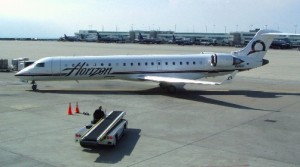What might the reduction in regional air services mean for intercity transit?
Across the United States, air service for lower population regions is being reduced or eliminated. In July, the New York Times reported that Delta Airlines is eliminating service for 24 small airports. My hometown airport, Eureka/Arcata (ACV), for example, has lost the service of two carriers in recent years. The airport is now served by one carrier.

Serving regional airports that have less travel demand is expensive. 30-50 passenger aircraft serving these airports often fly at half-capacity. Many travelers don’t like prop-aircraft, and instead prefer to travel on regional jets, which are less efficient and more expensive to operate.
Air service to small communities is useful for business travelers and important for facilitating connections with greater world. One air link to a large hub airport provides a gateway for worldwide travel. Recognizing this, the U.S. government “Essential Air Service” program is intended to allow small communities to maintain commercial service by subsidizing select routes that would otherwise be unprofitable. The subsidy program is expensive: the approximate subsidy per passenger is $74, excluding the Alaska market, according to a 2006 New York Times article, “Subsidies Keep Airlines Flying to Small Towns”.
In light of the social and business costs of reduced travel access, as well as the cost of subsidizing air service to rural markets, it makes sense consider alternative ground-based options for travelers to connect with hub airports.
In Oregon, the HUT Airport Shuttle offers frequent service from nearby towns (some with their own regional airports) to the Portland Airport (PDX). The shuttle offers onboard wi-fi. In Idaho, Wyoming, Montana, and Utah, Salt Lake Express offers frequent service to the Salt Lake Airport.
I’m sure there are many other great examples of regional ground transportation service connections to a hub airport. These services make so much sense. Because it costs less to operate, bus or shuttle service connections to an airport can operate more frequently than air service connections. Greater frequency potentially means reduced connection times at the hub airport, allowing overall travel time for ground-air itineraries compare favorably with all-air. Ground-based transit service is also usually less expensive for travelers (and taxpayers). Passengers can use wi-fi onboard. Finally, ground-based public transportation does not consume as much fuel or pollute nearly as much as air travel.
There are several ways that we can develop and promote ground-based transportation as a viable connection to hub airports. Earlier, I posted about a Continental Airlines and Amtrak codeshare arrangement — a creative way to address the “last mile” issue for air travel. Air/rail codeshare arrangements are more popular in Europe. Creating more of these arrangements will make it easier for travelers to find opportunities to make air/ground transportation connections.
The travel booking site Hipmunk shows Amtrak and flight options on one page, helping travelers to identify the best value and most convenient in travel options. (See “Hipmunk shows rail and air travel options, hotel walkability”.) A truly complete travel reservations site needs to show intercity bus, rail, and air options. Travel reservations sites will offer a great service to their users if they begin listing all available options, instead of exclusively air travel.
The public transportation and the travel planning experience better by with integrated travel information. Many travelers already consider whether, for example, it makes the most sense to travel using Salt Lake Express from Idaho Falls to connect with a flight in Salt Lake City, or to fly directly from Idaho Falls and connect through Salt Lake City. To make this comparison, it’s necessary to look at at least two websites. The comparison process can be made easier with better travel information websites. In the future, Hipmunk, Kayak, Expedia, Orbitz and other travel sites should expose and allow travelers to quickly compare combined-mode itineraries.
Does any blog reader know of any policy initiatives in the United States that recognize that ground-based transportation can be an effective, more efficient, and less emissions-intensive alternative to regional air services? Can anyone share more examples of multi-modal partnerships and travel booking websites?
One thought on “What might the reduction in regional air services mean for intercity transit?”